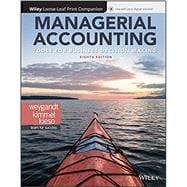Managerial Accounting provides students with a clear introduction to fundamental managerial accounting concepts. One of the major goals of this product is to orient students to the application of accounting principles and techniques in practice. By providing students with numerous opportunities for practice with a focus on real-world companies, students are better prepared as decision makers in the contemporary business world.








